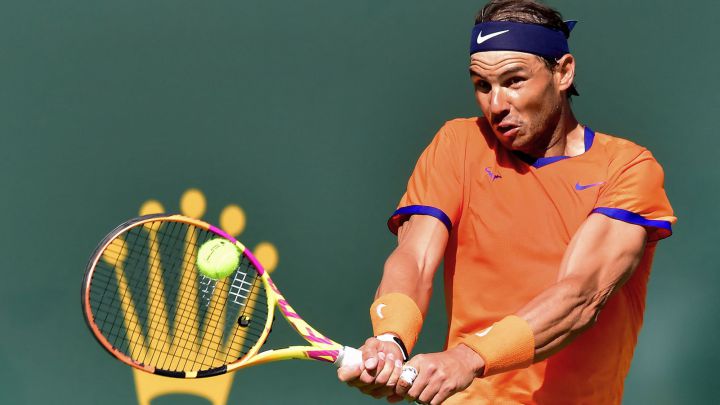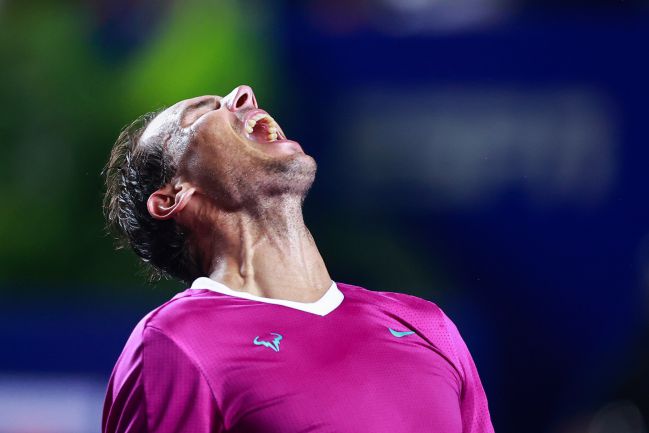
Neurotransmitters, physical-chemical reactions, lateralization, winning effect… When Luis Cerdá and David Barberá try to explain Rafa Nadal’s current success, they are forced to bring out their best shots. Nothing is saved, like the Spanish tennis player, who today faces Reilly Opelka, 17 in the world, in the round of 16 in Indian Wells, where he continues to extend his best start ever (clean, with 17 wins in a row). Cerdá, who dedicates part of his research to analyzing the mental processes of elite athletes, is co-director of the Master’s Degree in Neuromarketing at the International University of La Rioja (UNIR); Barberá, at the same academic center, directs a postgraduate course on physical preparation and sports rehabilitation. Both, as anyone would, can not help but move away from their technical language to succumb to emotions. It is what causes the manacorí. “He’s a wonder, this guy is a wonder!” Professor Barberá exclaimed during the conversation with this newspaper. “We have tools that allow us to explain the explainable …”, Cerdá’s colleague resigns, at times, who dares to joke: “From a very selfish look, to see if he retires soon and lends himself to be studied as if he were a laboratory mouse…”. After amusing moments of doubt, she discards the idea: “No, no, we are going to enjoy him and see how far he goes,” she corrects.
It is difficult to predict. Even for them, familiar with the big data and all its possibilities. With the math being taught after questioning Nadal’s heroic ability, it also doesn’t seem like the best time. The win predictor of the Australian Open, leaving a television image for posterity, showed the following victory percentages in the final between the Spaniard and Daniil Medvedev: 96%-4% in favor of the Russian player. With two sets down and the coldness of the brief world number one, twice beaten in Acapulco, no one can blame the algorithm. Common sense dictated the same path; but not Nadal’s, which has little current. “In minds like his, at that moment, those are not the present percentages: he only thought that he had a 50% chance of winning the next point,” Cerdá begins to explain. As in the third set against Sebastian Korda in Indian Wells, with a 5-2 against overcome.

Enlarge
Nadal, a force of nature.
Hector Vivas (Getty Images)
The success of the 21-time Grand Slam winner, according to the doctor, must be analyzed from three perspectives: biological, psychological and social. From the combination of the three, the formula that beat the equations is extracted. “Nadal’s achievements have much of a mental nature, but they are also due to a series of physical-chemical reactions that he has enhanced through training and a great ability to interpret the most immediate environmentto be empathic with him”, he extends. A necessary prologue to understand the failure in the Australian system: “Artificial intelligence has not yet reached perfection in its models in variables such as environmental conditions, the incidence of a specific applause, the weather etc. Or even in the winning effect. That winning effect that, through an increase in dopamine levels, can tip the scales in all-or-nothing situations. Everything is closely related to that empathy with the environment that Nadal has so developed,” he concludes. Matchball, Big Data.
A complex mind…
Playing the piano is one of the most demanding activities at the brain level. According to neuroscientist Gottfried Lau, musical instruments put almost all areas of the brain to work simultaneously. The 88 keys, in particular, stand out above the rest: the movements of both hands must be coordinated and, with it, It increases the activity of both cerebral hemispheres at the same time. Being able to do so requires dedication, but has proven benefits. Nadal, on the track, has been playing the piano throughout his career.
“In minds like yours, you only think that there is a 50% chance of winning the next point”
Luis Cerdá, co-director of the Master in Neuromarketing at UNIR
The tennis player from Manacor is right-handed, but he plays with his left. At the age of eight, he could already serve with his left foot and based his game on two-handed hitting. A gold mine that his uncle and former coach, Toni Nadal, and Jofre Porta, with a lifetime dedicated to tennis training and research, knew how to take advantage of. “Humans have crossed hemispheres. The hawk eye of right-handers is the left one. Nadal has crossed lateralization. His left hemisphere is originally the most active, but the right has not accommodated because he plays with the left. The two work and that is a great advantage, because the spectrum and psychomotor capacity are broadened”, explains David Barberá. On the track, beyond the benefits at a mental level, it has direct implications. Even technical ones. “What about that backhand? But that’s a forehand!”exclaimed José Antonio Mielgo during the final in Acapulco between the Balearic and Cameron Norrie, duel Rare avis given the “left-handed” condition of both tennis players. “The cross lateralization allows Nadal, among other things, to be so special in his backhand. When he uses this tool, beyond leaning on his right hand, he also works from his left hemisphere, the theoretically dominant one in his case”, Barberá develops.
Upside down to a putt practically professional, going through a skill in the poker which has led him to challenge the number one in the world in the field, Vanessa Selbst. Each cerebral hemisphere enhances certain abilities in the human being. The law, spatial intelligence, perception, intuition or creativity; the left, the capacity for analysis, logic, mathematics or linearity. Nadal, with his genuine profile, maintains a balance with the key to many doors. “Not all people can have such a marked lateralization no matter how much training they have. Rafa is lucky to have this genetic capacity,” concludes Barberá. A chosen one.
…and a body without limits
Drag with your right foot to clear the line. Racquet strike on the left and right heel, in this order. Ball discarded, ball in the pocket, hand to the back of the pants, then left shoulder, right shoulder, right ear, left ear, nose, and back to the right. Every Nadal fan has this ritual engraved in their subconscious. Diagonal bottles, towel always in the same position, racket change every eight games, cold shower, jumps in the tunnel… Nothing is a coincidence. “Before a match, neurons boil and testosterone levels rise, especially with success, which makes us more aggressive. When you lose, on the contrary, it is cortisol that rises. High-level athletes have this cycle very active. Now, it is being shown that the human brain is capable of intuitingwith small signs, one’s own reactions and those of the opponents”, explains Luis Cerdá. A way of putting the body on alert, a routine – “habits translate into behavior”, the teacher continues explaining – in which to protect oneself.
And the serve arrives, when the body begins to run. In the case of Rafa, one that has endured three and a half years of injuries. One that, currently, must cohabit with the Müller Weiss syndrome, a degenerative ailment that leads him to play with the scaphoid bone of his left foot practically broken. “Her case is highly complex, because age plays against it. But I honestly believe that Rafa could overcome any type of injury,” Barberá dares to assure, succumbing, once again, to admiration. “The best way to stay is to take care of the conditional level (strength, endurance, speed and flexibility) and to know one’s limits”, continues, already in a more scientific way. “Tennis requires a fast force that, over the years, goes down along with the hormonal levels, from the neurotransmitters to the chemical neuronal system. At that moment the mind goes faster than the physiological level. It is a proven and widespread process. With nuances, as is the case with Nadal. Thanks to his adaptive levels and despite everything… he looks as if he were 25 years old!”, he exclaims again. Speaking of Rafa, it is impossible not to do it. Even for science, a break down.